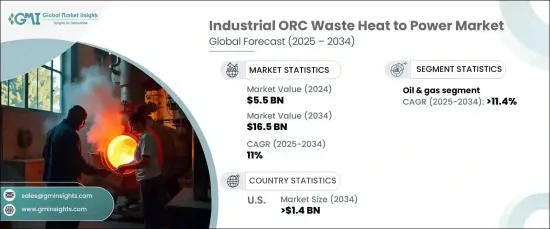
|
市場調査レポート
商品コード
1667128
産業用ORC廃熱発電市場の機会、成長促進要因、産業動向分析、2025~2034年の予測Industrial ORC Waste Heat to Power Market Opportunity, Growth Drivers, Industry Trend Analysis, and Forecast 2025 - 2034 |
||||||
カスタマイズ可能
|
|||||||
| 産業用ORC廃熱発電市場の機会、成長促進要因、産業動向分析、2025~2034年の予測 |
|
出版日: 2024年12月31日
発行: Global Market Insights Inc.
ページ情報: 英文 110 Pages
納期: 2~3営業日
|
全表示
- 概要
- 目次
世界の産業用ORC廃熱発電市場は、2024年に55億米ドルと評価され、2025年から2034年にかけてCAGR 11%で成長すると予測されています。
この市場は、エネルギー効率と持続可能性が重視されるようになったため、急速に拡大しています。産業界が二酸化炭素排出量の削減と環境基準の遵守に努める中、ORC技術は信頼できるソリューションとして台頭してきています。廃熱を利用し、利用可能な電力に変換する能力は、エネルギー消費を最適化するだけでなく、運用コストも最小限に抑えます。セクターを問わず持続可能な実践への注目が高まっていることも、こうしたシステムの採用をさらに後押ししています。

製造業や重工業プロセスを含むさまざまな産業では、操業中に大量の廃熱が発生します。ORCシステムを導入することで、これまで無駄になっていたこのエネルギーの有効利用が可能になり、効率の向上とコスト削減に貢献します。政府の支援政策とインセンティブが、この技術への投資を促進しています。多くの国が、再生可能エネルギーの導入を促進し、排出削減目標を達成するための広範な戦略の一環として、エネルギー効率の高い技術を優先しています。税制優遇や補助金などの財政支援により、ORC技術は、エネルギー管理能力を強化しながら規制要件を満たそうとする企業にとって魅力的な選択肢となっています。
| 市場範囲 | |
|---|---|
| 開始年 | 2024 |
| 予測年 | 2025-2034 |
| 開始金額 | 55億米ドル |
| 予測金額 | 165億米ドル |
| CAGR | 11% |
市場は用途別に分類され、石油・ガス、金属、ガラス、セメントなどの分野が含まれます。石油・ガスセクターは特に力強い成長を遂げており、ORCシステムの応用により、運転効率や厳しい環境基準への準拠といった主要課題に対処しています。この分野でのこの技術の採用は、エネルギー節約と規制遵守という2つの利点が原動力となっています。この分野のCAGRは2034年まで11.4%を超えると予測されており、これは業界全体で採用が進んでいることを反映しています。
米国では、産業用ORC廃熱発電市場は2034年までに14億米ドルを超えると予測されています。同国では、二酸化炭素削減や持続可能なエネルギー利用を推進する政府の取り組みに後押しされ、エネルギー効率の高い技術に対する需要が高まっています。ORCシステムは、廃熱が大量に発生する製造業や化学処理などのエネルギー集約型産業で支持を集めています。持続可能性の向上と温室効果ガス排出量の削減に重点を置く規制の枠組みが、市場の成長をさらに後押ししています。
このような進化する情勢は、ORC技術が産業用エネルギー管理の近代化に不可欠なツールとして変革の可能性を秘めていることを浮き彫りにしており、経済効率を維持しながら持続可能性の目標を達成するビジネスを支援しています。ORCシステムの採用は、環境問題やエネルギー課題への対処を目指す産業界にとって、重要な戦略となりそうです。
目次
第1章 調査手法と調査範囲
- 市場の定義
- 基本推定と計算
- 予測計算
- データソース
- 1次データ
- 2次データ
- 有償
- 公的
第2章 エグゼクティブサマリー
第3章 業界洞察
- エコシステム分析
- 規制状況
- 業界への影響要因
- 促進要因
- 業界の潜在的リスク&課題
- 成長可能性分析
- ポーターの分析
- 供給企業の交渉力
- 買い手の交渉力
- 新規参入業者の脅威
- 代替品の脅威
- PESTEL分析
第4章 競合情勢
- 戦略ダッシュボード
- イノベーションと持続可能性の展望
第5章 市場規模・予測:用途別、2021年~2034年
- 主要動向
- 石油・ガス
- セメント
- ガラス
- 鉄鋼・金属
- その他
第6章 市場規模・予測:地域別、2021年~2034年
- 主要動向
- 北米
- 米国
- カナダ
- メキシコ
- 欧州
- トルコ
- ドイツ
- イタリア
- ロシア
- アジア太平洋
- 中国
- タイ
- ブルネイ
- 世界のその他の地域
第7章 企業プロファイル
- Alfa Laval
- Aura
- Bihl
- Calnetix Technologies
- Climeon
- Durr Group
- Exergy International
- General Electric
- IHI Corporation
- Kaishan USA
- Mitsubishi Heavy Industries
- Ormat Technologies
- Siemens
- Strebl Energy
- TransPacific Energy
- Turboden
The Global Industrial ORC Waste Heat To Power Market was valued at USD 5.5 billion in 2024 and is projected to grow at a CAGR of 11% from 2025 to 2034. This market is advancing rapidly due to the increasing emphasis on energy efficiency and sustainability. As industries strive to reduce their carbon footprints and comply with environmental standards, ORC technology is emerging as a reliable solution. The ability to harness waste heat and convert it into usable power not only optimizes energy consumption but also minimizes operational expenses. The growing focus on sustainable practices across sectors further reinforces the adoption of these systems.

Various industries, including manufacturing and heavy industrial processes, generate substantial amounts of waste heat during operations. The implementation of ORC systems enables the effective utilization of this previously wasted energy, contributing to improved efficiency and cost savings. Supportive government policies and incentives are fostering investments in this technology. Many countries are prioritizing energy-efficient technologies as part of their broader strategies to promote renewable energy adoption and achieve emission reduction targets. Financial support, such as tax benefits and grants, has made ORC technology an attractive choice for businesses looking to meet regulatory requirements while enhancing their energy management capabilities.
| Market Scope | |
|---|---|
| Start Year | 2024 |
| Forecast Year | 2025-2034 |
| Start Value | $5.5 Billion |
| Forecast Value | $16.5 Billion |
| CAGR | 11% |
The market is categorized by applications, encompassing sectors such as oil and gas, metals, glass, cement, and others. The oil and gas sector is witnessing particularly robust growth, with the application of ORC systems addressing key challenges such as operational efficiency and compliance with stringent environmental norms. The sector's adoption of this technology is driven by the dual benefits of energy savings and regulatory compliance. The projected CAGR for this segment exceeds 11.4% through 2034, reflecting its increasing adoption across the industry.
In the United States, the industrial ORC waste heat to power market is forecast to surpass USD 1.4 billion by 2034. The country is experiencing rising demand for energy-efficient technologies, spurred by government initiatives promoting carbon reduction and sustainable energy practices. ORC systems are gaining traction in energy-intensive industries, including manufacturing and chemical processing, where substantial waste heat is generated. Regulatory frameworks focused on enhancing sustainability and reducing greenhouse gas emissions further contribute to market growth.
This evolving landscape highlights the transformative potential of ORC technology as an essential tool in modernizing industrial energy management, supporting businesses in achieving their sustainability goals while maintaining economic efficiency. The adoption of ORC systems is poised to become a key strategy for industries aiming to address environmental concerns and energy challenges.
Table of Contents
Chapter 1 Methodology & Scope
- 1.1 Market definitions
- 1.2 Base estimates & calculations
- 1.3 Forecast calculation
- 1.4 Data sources
- 1.4.1 Primary
- 1.4.2 Secondary
- 1.4.2.1 Paid
- 1.4.2.2 Public
Chapter 2 Executive Summary
- 2.1 Industry synopsis, 2021 – 2034
Chapter 3 Industry Insights
- 3.1 Industry ecosystem analysis
- 3.2 Regulatory landscape
- 3.3 Industry impact forces
- 3.3.1 Growth drivers
- 3.3.2 Industry pitfalls & challenges
- 3.4 Growth potential analysis
- 3.5 Porter's analysis
- 3.5.1 Bargaining power of suppliers
- 3.5.2 Bargaining power of buyers
- 3.5.3 Threat of new entrants
- 3.5.4 Threat of substitutes
- 3.6 PESTEL analysis
Chapter 4 Competitive landscape, 2024
- 4.1 Strategic dashboard
- 4.2 Innovation & sustainability landscape
Chapter 5 Market Size and Forecast, By Application, 2021 – 2034 (USD Million & MW)
- 5.1 Key trends
- 5.2 Oil & gas
- 5.3 Cement
- 5.4 Glass
- 5.5 Steel & metals
- 5.6 Others
Chapter 6 Market Size and Forecast, By Region, 2021 – 2034 (USD Million & MW)
- 6.1 Key trends
- 6.2 North America
- 6.2.1 U.S.
- 6.2.2 Canada
- 6.2.3 Mexico
- 6.3 Europe
- 6.3.1 Turkey
- 6.3.2 Germany
- 6.3.3 Italy
- 6.3.4 Russia
- 6.4 Asia Pacific
- 6.4.1 China
- 6.4.2 Thailand
- 6.4.3 Brunei
- 6.5 Rest of World
Chapter 7 Company Profiles
- 7.1 Alfa Laval
- 7.2 Aura
- 7.3 Bihl
- 7.4 Calnetix Technologies
- 7.5 Climeon
- 7.6 Durr Group
- 7.7 Exergy International
- 7.8 General Electric
- 7.9 IHI Corporation
- 7.10 Kaishan USA
- 7.11 Mitsubishi Heavy Industries
- 7.12 Ormat Technologies
- 7.13 Siemens
- 7.14 Strebl Energy
- 7.15 TransPacific Energy
- 7.16 Turboden


